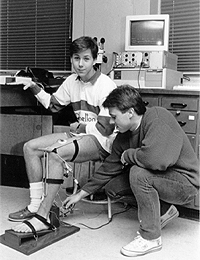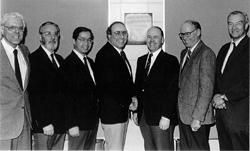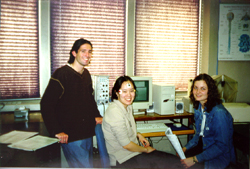| 1949-1965: The Ascent of Modern Times
|
|
| A new "state of the art" student laboratory was also established. The Departmental mechanical and electronics workshops continued to innovate. The first electronic averaging computer capable of on-line (digital or analogue) autocorrelation was designed and produced. A demonstration oscilloscope for on-line display to groups of students of nerve and muscle action potentials and other high frequency phenomena was also fabricated as well as a flame photometer with electronically amplified signal output. In 1954, the Honours BSc program was inaugurated in order to eventually attract students into both basic and clinical research. T.M.S. Chang, P. Gold and M. Levy were among the first students to have entered such a program. In 1964, Respiratory Mechanics (with Dr. J. Milic-Emili, who would become the head of the Meakins-Christie Laboratories) was added to the Department’s research and teaching strong points. | |
| From the mid-fifties to the mid-sixties, centres or research units were created: the Anaesthesia Research Department (in 1965, Dr. K. Krnjevic became the department’s director), the Aviation Medical Research Unit (later to be renamed Aerospace Medical Research Unit) with Dr. Geoffrey Melvill-Jones. The Artificial Organs Research Unit (later to become the Artificial Cells and Organs Research Centre of McGill University) under Dr. T. M. S. Chang came to existence. The Cancer Research Centre whose first director was Dr. Phil Gold (a Physiology Honours Graduate) maintained close relations with Physiology. | |
| In 1965, the McIntyre Building was completed and Physiology was allotted the 10th, 11th and part of 12th floors. |  From McGill News: The 1960s (Page 3) Volume 79, Number 4, Winter 1999-2000 |
| The Seventies: Rethinking Physiology Older research programs were maturing well such as topics related to synaptic and electrophysiological mechanisms and respiratory physiology with David V. Bates (Royal Victoria Hospital), J. Milic-Emili and Peter Macklem. Renal, muscle and motor physiology together with transplant immunology and special senses research were expanding. The intellectual climate began to unfavour the more descriptive wholistic organ centeredness of biomedical disciplines. Approaches that would tend to blur boundaries and to apply the physics and chemistry content of Physiology were developed. The addition of new basic science was popular. | |
| Thus, the chemistry and biophysics of artificial cell membranes sprang into being in 1975. M. Mackey and L. Glass started the foundations for the Department's biomathematics group (in 1989, the Centre for Nonlinear Dynamics in Biology and Medicine came into effect.) | |
| The original idea for these developments had been planted by David Firth, a particle physicist, who in the mid-sixties had joined the Department, and who left in 1975 after a 10-year stay to become a farmer. |  |
| The teaching of Physiology experimented with the introduction of modular self-teaching aids, lecture taping and with audio-visual material. Some staff members (Drs. Birks, Melvill-Jones, MacIntosh and Mandl) began producing instructional videotapes (dissection of the frog, blood pressure in the cat, spinal reflexes, muscle potentials, and vestibulo-ocular mechanisms). | |
The Eighties and Nineties: Toward a New Millennium Research With the eighties, departmental expertise is developing in the areas of endocrinology and cardiovascular physiology.  Cardiovascular physiology: Aoxiang Xu & Michael R. Guevara: "Two forms of spiral-wave reentry in an ionic model of ischemic ventricular myocardium." Chaos, Volume 8, Number 1 (March 1998).
|  "Mathematiciens du coeur" appeared in Quebec Science, vol 36, no 5 February 1998. One of the 10 discoveries of 1997 referenced in that magazine. The original work by Kevin Hall , David J. Christini, Maurice Tremblay, James J. Collins, Leon Glass, Jacques Billette was published in Physical review Letters, vol. 78, no 23, June 9th, 1997 with the title: Dynamic Control of Cardiac Alternans. |
| Respiration: "Breathing through skin in a newborn mammal" Nature 25 February 1999 J. P. Mortola P. B. Frappell & P. A. Woolley: "The exchange of oxygen and carbon dioxide through the skin does not occur in most mammals because they have high metabolic rates and diffusion through the skin is poor. But we have found that in the Julia Creek dunnart (Sminthopsis douglasi), a marsupial mouse with one of the smallest newborns of any mammal, gas exchange through the skin is the predominant form of O2 and CO2 transfer in the first days after birth." 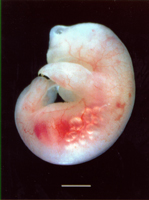 | Emphasis is also placed on cell and molecular biology where major advances have been made in the analysis of the genes controlling molecular responses of cells to physiological signals.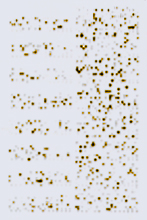 The results of a gene array are shown above, where the expression of over 4,000 genes was probed simultaneously. The intensity of the spots reflects the level of expression of a given gene and thus the protein encoded by that gene. In this case, the genes were expressed in a cancer cell treated with vitamin D3, which inhibits its growth (image provided by Dr. J. White). |
| Teaching In 1986, the undergraduate teaching laboratories are equipped, for the first time at McGill, with computerized data acquisition instrumentation to cover topics in electro physiology (resting membrane potential, compound action potential, EMG, EOG, ECG) as well as other subjects. Ten groups of students are thus introduced to modern recording techniques. The amplifiers and adjunct equipment were built by John Knowles, in the electronics workshop of the Department, keeping with the tradition of in-house technological advance.
|
Between Drs. G. Mandl (left) and Dr. Cruess (right), the class of 1961 Medicine representatives (among them, from left to right Drs. M. Levy, T.M.S. Chang, and P. Gold) presented the Department of Physiology with a very generous gift for the Physiology Teaching Laboratory on the occasion of the 25th, 30th anniversary of graduation.
|

